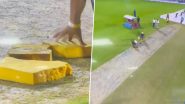Washington [US], December 10 (ANI): Is the concept of the burial of dead exclusive to our species or was it something that our closest ancient relatives, the Neanderthals practised? A new study indicates in favour of the latter hypothesis, but some scientists still remain a sceptic.
For the first time in Europe, at the CNRS and the Museum national d'histoire naturelle in France and the University of the Basque Country in Spain, a multi-disciplinary team led by researchers have demonstrated using a wide variety of criteria that a Neanderthal child was buried, probably around 41,000 years ago, at the Ferrassie site in Dordogne.
The study which was published in the journal Scientific Reports has revealed that dozens of Neanderthal skeletons have been found buried in Eurasia. This has lead scientists to believe that the Neanderthal's too like us used to bury their dead. However, many other scientists are still sceptical given the fact that the majority of these best-preserved skeletons were found at the beginning of the 20th century and were not excavated using modern archaeological techniques.
A human skeleton was analysed from one of the most famous Neanderthal sites in France: the La Ferrassie rock shelter in Dordogne by an international team led by paleoanthropologists Antoine Balzeau (CNRS and Museum national d'histoire naturelle, France) and Asier Gomez-Olivencia (University of the Basque Country, Spain).
Also Read | Bigg Boss 14: Eijaz Khan Discusses Pavitra Punia With Kashmera Shah, Says ‘Woh Mujhe Bohot Pasand Hai’.
After six Neandertal skeletons were found during the beginning of the 20th century, the site then delivered the seventh one between 1970 and 1973 which belonged to a child of around two years old. In the archives of the Musee d'archeologie Nationale, the collections associated with this specimen remained unexploited for almost half a century.
The excavation notebooks were recently reopened by a multidisciplinary team who reviewed the material and revealed 47 new human bones that were not identified then had undoubtedly belonged to the same skeleton. A thorough analysis of the bones, the study of proteins, state of prevention, dating, genetics, etc. was carried out by these scientists. In the hopes of finding further fragments of the skeleton, they returned to La Ferrassie. Even though no new bones were discovered, they were still able to reconstruct and interpret the spatial distribution of human remains and the rarely associated animal bones using the notebooks of their predecessors.
According to the study published in the journal Scientific Reports, while the other stratigraphic layers of the site inclined to the north-east, the researchers showed that the skeleton had been buried in a sedimentary layer which inclined to the west (the head, to the east, was higher than the pelvis). The relatively unscattered bones remained in their anatomical position.
Their preservation was better than that of the bison and other herbivores found in the same stratum which in turn indicates towards a rapid burial after death. Furthermore, the contents of this layer proved to be even older than the surrounding sediment there. Finally, a tiny bone identified as Neanderthal by its mitochondrial DNA and as a human by the proteins was directly dated using carbon-14. This makes it one of the most recent directly dated Neanderthal remains, at around 41,000 years old.
Though this new information did prove that the body of this Neanderthal child was intentionally deposited in the pit dug around 41,000 years ago in the sedimentary layer, still, further discoveries are needed to understand the geographical extension and the chronology of Neanderthal burial practices. (ANI)
(This is an unedited and auto-generated story from Syndicated News feed, LatestLY Staff may not have modified or edited the content body)













 Quickly
Quickly















